Mac users have never had it so good in terms of a choice of great
Web browsers. Rating my favorites among what are all pretty good solid
applications by historical browser standards is like shooting at moving
targets, but here is how I personally rank the current crop. (I say
"favorites" rather than "best browsers", because it's partly a matter
of subjective taste, and what works best for me may not be the ideal
choice for you.)
- Opera 10 Alpha
- Firefox 3
- iCab 4
- Safari 3
- Cruz
- Camino
- Sunrise
1. Opera 10 Alpha
I'm using the brand new public alpha release of the next-generation
Opera 10 as my main Web surfing application. I have, over four days use
- some of it fairly intensive - encountered no reason to revert back to
the current Opera 9.6.2. Indeed, there isn't any discernible bugginess
at all. This wasn't a total surprise, as I've had extremely good luck
with Opera pre-release builds in the past, including alphas that I've
found to be more reliable and stable than other browsers' final
releases.
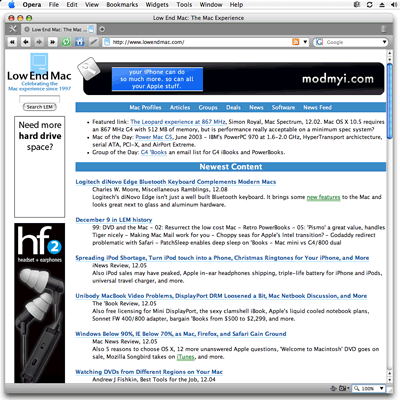
The version 10 alpha previews of Opera's new Presto 2.2 rendering
engine, which is claimed to offer 30% faster browsing compared to with
the current Opera Presto 2.1 that Opera 9.5 to 9.6.2 uses. Opera's
developers have also optimized the Opera Presto 2.2 engine to be much
faster on resource intensive pages such as Gmail and Facebook. With an
Acid3 100/100 score, Web Fonts support, RGBA/HSLA color, and SVG
improvements, Opera 10 alpha is designed to be ready for the next
generation of Web applications.
I'm a consummate Opera fan. I love its speed and its full feature
set with tabbed browsing, popup blocking, the ability to restore the
last session, full screen mode, mouse gestures support, quick,
efficient and handy zoom function that can magnify pages up to 1000%
and shrink them down to 20% from a menu on the main window, easy
toggling image display on and off (I'm still on dialup), its elegant
threading that allows you to switch between loading tabs (I often have
a dozen or more coming in simultaneously) without hesitation or delay,
its superb download manager (with pause and resume that work reliably),
extensive customizability, and, for those so inclined, there's a
built-in email client and newsreader.
The browser's Opera Link feature synchs your bookmarks and Opera's
unique Speed Dial between your computers and mobile phone. Log in with
your Opera username, and your data will always be accessible.
However, notwithstanding it's "everything including the kitchen
sink" feature set, Opera is relatively small and nimble, and I find the
interface intuitive, unobtrusive, and attractive.
For pages that try to use too much space and produce a horizontal
scrollbar, there is the "Fit to window width" option that readjusts the
page to remove the horizontal scrollbar, while still making it readable
at almost any window width.
Opera's Mouse Gestures let you use mouse movements to control
navigation. You can browse between pages, open and close windows, and
navigate links with quick mouse movements.
Opera lets you control popups. You can configure it to block them
all or open only popups that you have requested.
Opera continues to get my vote as best all-round browser. Use the
version 10 alpha if you're adventurous, or version 9.62 if you want
tried and true.
Link: Opera 10 Alpha
2. Firefox 3.0.4
Another browser I use a lot is Firefox, which since the release of
version 3 for the Mac has finally come into its own as a very pleasant
browser. My favorite Mozilla Gecko-based browser remains Netscape
Navigator 9, but development of it was terminated last spring, and I've
found Firefox 3 to be the most satisfactory substitute. Actually, you
can get an interface skin for Firefox that makes it look like Navigator
9, but I'm not much for messing around with plugins, although I make an
exception for WeatherBug.
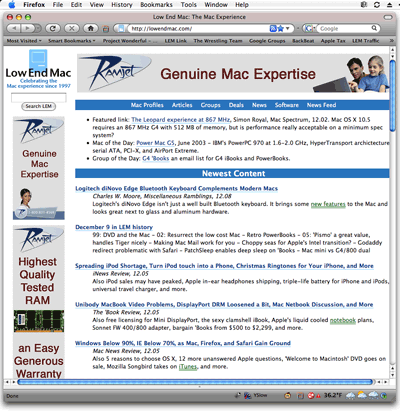 Firefox 3 for
Mac has a much-improved and more attractive user interface compared
with earlier Firefox versions, with a more native Mac OS X look,
smaller buttons, more compact tabs, and new forward/back buttons. I
like the new Firefox interface a *lot* better than the old one, but I
still think Opera and iCab have the edge in interface attractiveness.
One thing I'm not taken with is Firefox's tiny page load progress bar
at the bottom of the window. I've gotten used to progress bars at the
top, a la Safari and Opera.
Firefox 3 for
Mac has a much-improved and more attractive user interface compared
with earlier Firefox versions, with a more native Mac OS X look,
smaller buttons, more compact tabs, and new forward/back buttons. I
like the new Firefox interface a *lot* better than the old one, but I
still think Opera and iCab have the edge in interface attractiveness.
One thing I'm not taken with is Firefox's tiny page load progress bar
at the bottom of the window. I've gotten used to progress bars at the
top, a la Safari and Opera.
The downloads manager has also been improved (although I still think
Opera has the best downloads manager in the business) with support for
searching through previous downloads, resuming downloads between
sessions, and it now displays the domain of the source site next to
each completed download. The Places feature, which organizes bookmarks
and browser history, has also been enhanced, offering improved search
functionality and a new Smart Bookmarks folder on the Bookmarks
Toolbar.
It is now possible to search History, tags and bookmarks with a
real, configurable search interface, and the Mac OS X version of
Firefox 3 now has full support for native widgets in forms.
Probably my favorite new feature in Firefox 3 is that before
shutting down Firefox puts up a dialog asking if you want to save the
contents of tabs in your current browsing session. In most instances I
definitely do, and the icing on the proverbial cake is that the tabs
get reloaded from the cache, which no longer gets dumped on shutdown if
you choose the save option with satisfying dispatch upon starting the
program again. This is a big enhancement from Firefox 2's ability to
remember the contents of tabs after program crashes.
Firefox's main shortcoming is perhaps that it's still a bit bland,
partly because it is extensively cross platform. However, its support
for plugin customization can remedy that for those inclined to tinker.
It's a speedy too, and now supports session restores, which is a huge
feature in my estimation.
Firefox also has the advantage of high site compatibility, While
Opera still occasionally chokes on a site, Firefox will usually load it
without drama.
Firefox 3 is based on the Gecko 1.9 Web rendering platform, which
was under development for nearly three years. Building on the previous
release, Gecko 1.9 has more than 14,000 changes including some major
re-architecting to provide improved performance, stability, rendering
correctness, and code simplification and sustainability. Firefox 3 has
been built on top of this new platform resulting in a more secure,
easier to use, more personal product with a lot more under the hood to
offer website and Firefox add-on developers. Suffice to say, Firefox 3
is fast - very fast - and in the same ballpark inhabited by other
speedster OS X browsers like Opera 9.50 and Safari 3.
System requirements: Mac OS X 10.4 and later
Minimum Hardware
- Macintosh computer with an Intel x86 or PowerPC G3, G4, or G5
processor
- 128 MB RAM (Recommended: 256 MB RAM or greater)
- 200 MB hard drive space
Link: Firefox
3. iCab 4.2.5
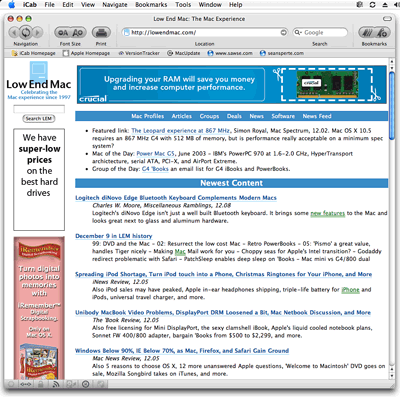 Another browser
I usually have up and running is iCab, a German indie browser that just
keeps quietly getting better and better, adding to its already
amazingly deep complement of useful and powerful features.
Another browser
I usually have up and running is iCab, a German indie browser that just
keeps quietly getting better and better, adding to its already
amazingly deep complement of useful and powerful features.
One thing that really strikes me about recent iCab builds is that
they start up like lightning - even faster than Safari, if my gut
impression serves me. Another is that while I've always liked iCab,
going back to experimenting with a German-language version back in the
late 90s, it's never been more likable than it is with the version
4.2.5 builds.
iCab is a niche player in the browser world with less than one
percent of the market (Low End Mac's logs put it at 0.1% among Mac
users), but it deserves a wider clientele on merit. It reminds me of
long-running ad campaign for a brand of beer here in Atlantic Canada,
which claims that "people who like it, like it a lot." The same goes
for iCab's fiercely loyal cohort of fans, and they have a point.
There is an awful lot to like about iCab, which I consider the
Mercedes Benz of browsers. It may not be the most potent powerhouse on
the Information Superhighway, but it's a tour-de-force of solid and
innovative engineering with a quality feel.
Cache Browsing
The last several beta builds of iCab 4.x have concentrated mainly on
Web page saving and cache browsing innovation, as well as the usual
incremental bug fixes. The new feature that grabs me the most is the
Cache Browser that is now available in the Tools menu if you're running
Mac OS X 10.5 "Leopard" and later. (Under Mac OS X 10.3 and
10.4, the Cache browser is not available because the format of the
cache files is unknown under these Mac OS versions.) The Cache Browser
window displays a list of all files that are stored in the web cache,
and it's possible to filter out certain items by
activating/deactivating the file type buttons or by entering some text.
There's also a preview available for all files. Through the contextual
menu it's also possible to save the files to disk. Very cool,
especially for folks like me who spend a lot of time working offline
and are stuck with a slow dialup connection.
Another very cool and handy new feature recently added to iCab is
the ability to save pages as PDF files.
If you've never checked out iCab, or if it's been a while since you
did, give this little browser a look. You may get hooked. The only
caveat is that while iCab has pledged from the outset that a free
version would always be available, it remains one of the last two
browsers (OmniWeb is the other) that requires a software license fee
for full support. A single user license of "iCab Pro" costs $25/25 EUR.
Entering your license code in iCab will switch off the "shareware
reminder" box. At the moment, the only restriction of the free version
is that annoying little "shareware reminder" box popping up from time
to time. Also users who have paid for a license are able to get newer
(beta) releases of iCab earlier than other users.
System requirements for iCab 4: Mac OS X 10.3.9 and newer, Mac
OS X 10.4.x or 10.5.x is recommended.
System Support: PPC/Intel
$25 shareware/freeware (nagware)
Link: iCab
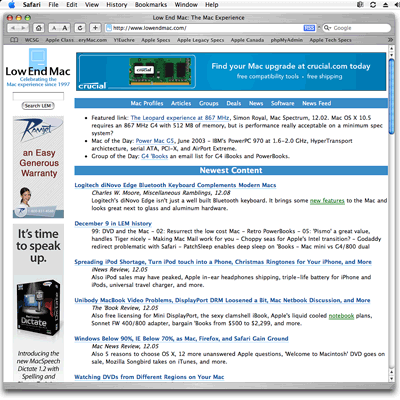 4. Safari 3
4. Safari 3
The OS X mothership browser, Safari installs by default with OS X,
and it's perfectly capable of serving most users' browsing needs very
competently. Safari, currently at version 3.1.2, is fast, stable, and
offers a comprehensive range of features.
That said, I've never really been a Safari enthusiast. I find the
interface plain-vanilla bland - and the features implementation
likewise. It starts up fast, loads pages with competitive speed, and
works well enough in general, but it lacks imagination, IMHO. Safari
users may also have to stay current with the latest OS X system
upgrade/update in order to have the most up-to-date Safari version.
Back in the plus column, Safari is stable, and you rarely run into a
Web page it can't handle. One oddball issue is that whether you use it
for browsing or not, you need Safari around so you can set your browser
default in its preferences (unless you have Camino), but since it
installs with the Mac OS, that's not really so much of a problem as a
quirk.
Link: Safari
5. Cruz
While I'm not a Safari devotee, I have found a WebKit based browser
I like a lot - Todd Ditchendorf's Cruz browser (which is Leopard only)
retains most of the good stuff from Safari, has a more interesting
interface, and includes some really convenient and useful advances in
browser functionality.
Cruz takes the familiar, solid WebKit browser engine and basic
Safari-esque front-end and adds a Firefox-style plugin architecture -
only with a native Cocoa plugin API that opens up virtually unlimited
customization and extension potential
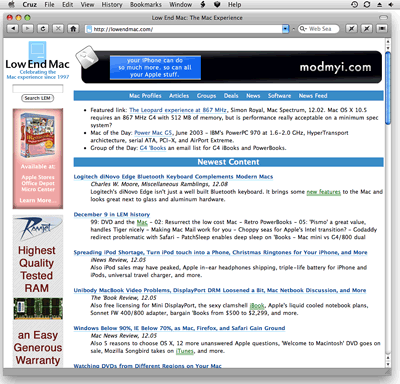 A couple of
plugins are included with Cruz, which is a modest 3.7 MB download,
including one called "BrowsaBrowsa" that allows you to display three
Web pages side-by-side in the same browser window or tab by way of two
hideaway sidebars toggled by buttons on the toolbar, each page
subwindow having its own address field and navigation buttons.
A couple of
plugins are included with Cruz, which is a modest 3.7 MB download,
including one called "BrowsaBrowsa" that allows you to display three
Web pages side-by-side in the same browser window or tab by way of two
hideaway sidebars toggled by buttons on the toolbar, each page
subwindow having its own address field and navigation buttons.
This is slick for doing side-by-side comparisons, coordinating
research from multiple resources, and keeping an eye on a particular
site while you surf in another site and/or have a search engine at the
ready. Obviously, it shines best on wide displays.
More unique and interesting Cruz features include a menu command
that takes you to a site called "Down for Everyone or Just Me?", which
lets you know if a website is having problems, and another that
instantly creates a "tiny URL" to replace the long web address string
for the page you're on. I use tiny URL conversions a lot, so this is a
really convenient time-saver for me.
Cruz also has a CoverFlow plugin that can display link thumbnails on
websites that support it, although I found that considerably less
useful than BrowsaBrowsa. It will also display thumbnail images in
Google search results that support it.
Cruz supports Greasemonkey scripts, and there's a "Mail Link To This
Page" command that may prove handy if you use the built-in OS X
Mail email client.
Yet another interesting and potentially useful wrinkle is a Web
Inspector window that can display page detail information and a Network
Timeline represented in color-coded bar graphs.
There's more: built-in user scripting, user styles, single-window
browsing mode, full-screen mode, integrated Gears-loading, custom
user-agent strings, and custom window opacity/level/style.
Stable and Speedy
Despite being a 0.1 release, Cruz has proved to be reasonably
stable. I've been running it now for nearly two months, using it a lot,
and have had just one crash in that time - and not much else in the way
of unwelcome behavior. Cruz is also at least as fast as Safari, if not
faster, which is to say satisfyingly speedy.
Negatives? Unfortunately, there is no bookmark import function yet,
something I expect will be added in a later build. Session Restore,
which I really can't abide being without anymore, is there already. It
works great for routine shutdowns and startups, but for some reason was
unable to recover the session I had open at the time of that one crash.
Having two Macs in production service still running Mac OS X 10.4
"Tiger", I was also disappointed that Cruz requires Leopard, but one
does have to eventually bow to the inevitable.
System requirements: Mac OS X 10.5
System Support: PPC/Intel
Link: Cruz
6. Camino 1.6.5
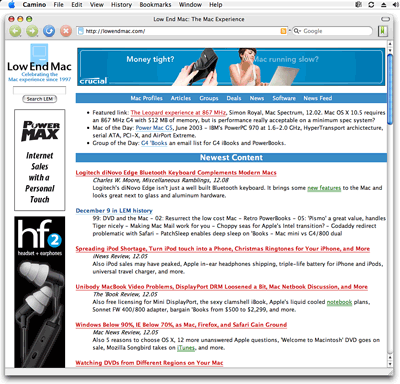 Camino is
another Mozilla Gecko based browser with the distinction of being the
sole Gecko variant that is Mac-only, and thus the only one with a
Cocoa-based user interface and feature set, such as support for OS X
Services.
Camino is
another Mozilla Gecko based browser with the distinction of being the
sole Gecko variant that is Mac-only, and thus the only one with a
Cocoa-based user interface and feature set, such as support for OS X
Services.
Camino is a swift, smooth, and refined browser combining Mac OS user
interface elegance with the powerful web-browsing capabilities of the
Gecko rendering engine, but for some reason I've never warmed to it
despite many attempts to adopt using it as a regular browsing tool over
the years. However, some folks, such as LEM publisher Dan Knight, are
partial to Camino, and I have no quarrel with them: Camino is a very
nice browser.
With its attractive looks and features like the system spellchecker
and session saving, Camino 1.6.5 provides plenty of reasons to make it
your default browser (and you can configure it as such in its own
Preferences).
Camino's support for session saving, or optionally remembering what
pages you were visiting when you quit and automatically loading them
the next time you start, is convenient. While crashes are not common,
Camino can now load the pages you were visiting when you start Camino
after it unexpectedly quit.
Camino's tabbed browsing includes tooltips to help you keep track of
all your tabs when you can't read their titles. "Single window mode"
tames sites that insist on opening new windows by forcing their new
windows to open in tabs, keeping window clutter to a minimum. With "tab
jumpback", when a site opens a new tab, you can "jump back" to the page
you were viewing simply by closing the new tab.
System requirements:
- Mac OS X 10.3.9 or later
- 50 MB free hard drive space
- 128 MB Ram
System Support: Camino 1.6.5 is a universal binary and runs natively
on both PowerPC- and Intel-based Macs.
Link: Camino
7. Sunrise 1.7.5 Web
Browser
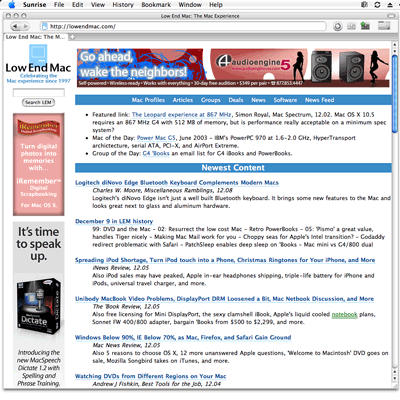 Sunrise is
pitched as a browser for web developers, and I'm not one, so I only
recently got around to checking it out. I was happily surprised.
Sunrise is
pitched as a browser for web developers, and I'm not one, so I only
recently got around to checking it out. I was happily surprised.
Sunrise uses Apple's WebKit rendering engine, which is part of
Safari, and is a very compact browser - a relatively minuscule 1.1 MB
download and only 2.4 MB when expanded. But despite its small size,
Sunrise has a pretty comprehensive feature set which includes:
- Thumbnail bookmarks - Bookmarks with a thumbnail image and a
title
- Window fader and auto-resize - The main window can be made
transparent and resized automatically from a toolbar command, with each
Web pages assuming the revised screen resolution. One-click window
resizing is toggled with a button that lets you cycle through 640
pixel, 800 pixel, 1024 pixel, and full screen widths.
- Search engine - You can configure your preference for the search
engine Sunrise accesses from its interface search field.
- View source - The source of the web page is displayed with your
favorite editor.
- Download files from URL - You can download the file by inputting
its URL.
- Transparent window (both web page window & source window)
- Sunrise can create a PDF file from a Web page with a keystroke
using the Page Shot feature - saving either just the portion of the
page visible in the window or the entire page.
- Page Zoom - Sunrise lets you to change the current page's view size
from 10% to 400% using a convenient pulldown menu on the toolbar,
without the page having to reload (a very handy feature shared with
Opera)
What's Sunrise like to use? Like Safari, it starts up smartly and
loads pages fast, with a pleasant, nimble feel to it. I like the
individual progress bars in each browser tab that are in my usual line
of sight and allow watching the respective progress of multiple pages
loading simultaneously. Why hasn't any other browser implemented
this?
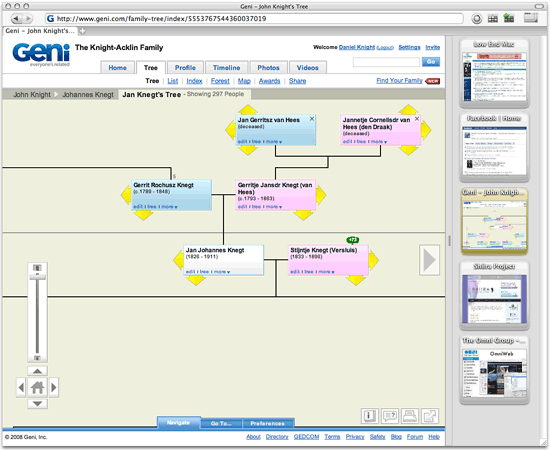
If you like the thumbnail bookmark concept that was pioneered by the
OmniWeb
folks, and is also used by another Japanese WebKit-based browser,
Shiira, Sunrise has an
interesting variation on the bookmark thumbnails theme, putting them in
a slide-in drawer that can be positioned at the bottom or the right,
with a button on the toolbar to toggle them in and out of sight. You
can adjust the thumbnails' size from 64 to 256px using a slider, and
color-code bookmark thumbnail borders to help find the one you're
looking for more quickly. The thumbnails also automatically update when
you access a Web page. You can also import your Safari bookmarks into
Sunrise.
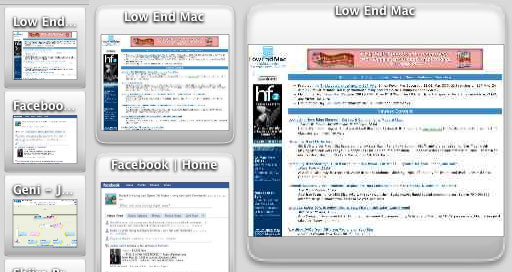
The downside is draggy response of the whole bookmark apparatus,
such as with opening and closing the sidebar and with loading my large
collection of bookmarks from Safari, at least on my concededly far from
cutting-edge 1.33 GHz G4
PowerBook. I expect Sunrise's performance would be more lively on
Intel Macs. I also wish there were an option to toggle an option of
conventional text list bookmark.
Other negative criticisms of Sunrise include that there is no way,
at least that I discovered, to turn off images loading, and a
particularly glaring omission these days is no resume session feature,
which I really am not happy being without any more.
I also found a troublesome incompatibility with the PBCentral news posting CGI, whose
Preview function refused to work from Sunrise, although I've had no
problem there with any other browser.
However, Sunrise's main shortcoming is in stability. For the past
several years I've found browser crashes to be pretty much a thing of
the past, with the browsers I use most often - Opera, Firefox, iCab,
Cruz, and Safari - all virtually as solid as the proverbial rock. Not
so, unfortunately, with Sunrise, which crashed with distressing
frequency on two different computers and operating system versions I
tested it with. I also found that merely restarting the browser didn't
always cure the problem, making a system reboot necessary. This,
combined with the lack of a session restore feature, would rule out my
using Sunrise for regular production work, which is too bad because in
may respects I really like this browser and likely would use it more if
those two problems were addressed.
System requirements: Mac OS X 10.3 or later
System Support: PPC/Intel
Free
Link: Sunrise
Conclusion
The six browser profiled above are not by any means the totality of
browser options for Mac OS X users these days. Other options
include the commercial software OmniWeb (WebKit based with thumbnail
bookmarks and a number of other unique features), Shiira (another
WebKit browser from Japan, also with thumbnail bookmarks); SeaMonkey (essentially the old
Netscape/Mozilla suite browser kept up to date with a contemporary
Firefox browser engine), Flock (a
Gecko-based social networking browser). and a gaggle of specialty
browsers. I haven't any quarrel with folks who like those browsers, but
I have not used any of them recently enough to warrant commenting.
Missing from the pack is Google's new Chrome browser, which has made
enough of a splash over on the Windows side that it's bumped Opera into
fourth place in market share. No Mac version of Chrome yet, but one is
promised, and that should shake things up a bit. Until then, CrossOver
Chromium is a port of the Windows version of Chrome for Intel Macs
and Linux machines.


 Firefox 3 for
Mac has a much-improved and more attractive user interface compared
with earlier Firefox versions, with a more native Mac OS X look,
smaller buttons, more compact tabs, and new forward/back buttons. I
like the new Firefox interface a *lot* better than the old one, but I
still think Opera and iCab have the edge in interface attractiveness.
One thing I'm not taken with is Firefox's tiny page load progress bar
at the bottom of the window. I've gotten used to progress bars at the
top, a la Safari and Opera.
Firefox 3 for
Mac has a much-improved and more attractive user interface compared
with earlier Firefox versions, with a more native Mac OS X look,
smaller buttons, more compact tabs, and new forward/back buttons. I
like the new Firefox interface a *lot* better than the old one, but I
still think Opera and iCab have the edge in interface attractiveness.
One thing I'm not taken with is Firefox's tiny page load progress bar
at the bottom of the window. I've gotten used to progress bars at the
top, a la Safari and Opera. Another browser
I usually have up and running is iCab, a German indie browser that just
keeps quietly getting better and better, adding to its already
amazingly deep complement of useful and powerful features.
Another browser
I usually have up and running is iCab, a German indie browser that just
keeps quietly getting better and better, adding to its already
amazingly deep complement of useful and powerful features.
 A couple of
plugins are included with Cruz, which is a modest 3.7 MB download,
including one called "BrowsaBrowsa" that allows you to display three
Web pages side-by-side in the same browser window or tab by way of two
hideaway sidebars toggled by buttons on the toolbar, each page
subwindow having its own address field and navigation buttons.
A couple of
plugins are included with Cruz, which is a modest 3.7 MB download,
including one called "BrowsaBrowsa" that allows you to display three
Web pages side-by-side in the same browser window or tab by way of two
hideaway sidebars toggled by buttons on the toolbar, each page
subwindow having its own address field and navigation buttons. Camino is
another Mozilla Gecko based browser with the distinction of being the
sole Gecko variant that is Mac-only, and thus the only one with a
Cocoa-based user interface and feature set, such as support for OS X
Services.
Camino is
another Mozilla Gecko based browser with the distinction of being the
sole Gecko variant that is Mac-only, and thus the only one with a
Cocoa-based user interface and feature set, such as support for OS X
Services. Sunrise is
pitched as a browser for web developers, and I'm not one, so I only
recently got around to checking it out. I was happily surprised.
Sunrise is
pitched as a browser for web developers, and I'm not one, so I only
recently got around to checking it out. I was happily surprised.


